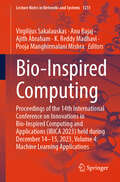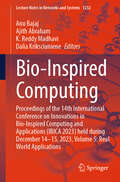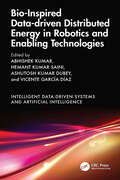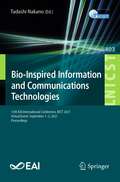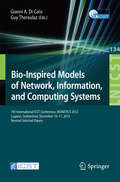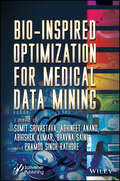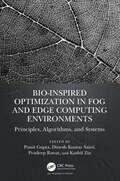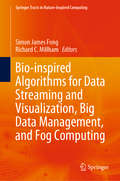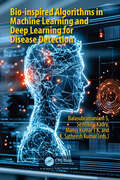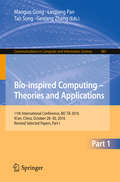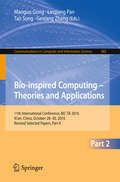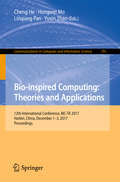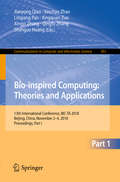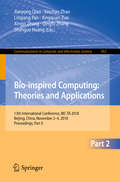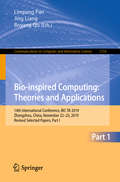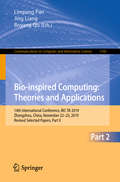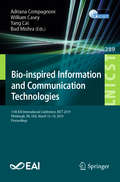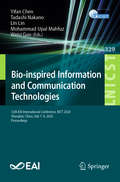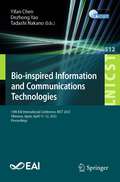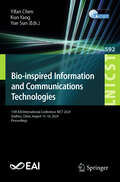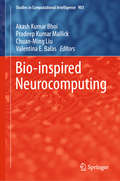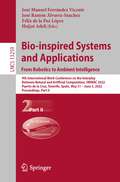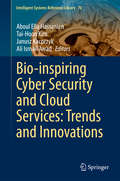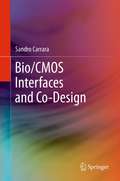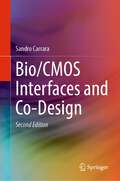- Table View
- List View
Bio-Inspired Computing: Proceedings of the 14th International Conference on Innovations in Bio-Inspired Computing and Applications (IBICA 2023) held during December 14-15, 2023, Volume 4: Machine Learning Applications (Lecture Notes in Networks and Systems #1231)
by Ajith Abraham Virgilijus Sakalauskas Pooja Manghirmalani Mishra Anu Bajaj K. Reddy MadhaviThis book presents 53 selected papers focused on Machine Learning and Applications from the 14th International Conference on Innovations in Bio-Inspired Computing and Applications (IBICA 2023) and 13th World Congress on Information and Communication Technologies (WICT 2023), which was held in five different cities namely Olten, Switzerland; Porto, Portugal; Kaunas, Lithuania; Greater Noida, India; Kochi, India and in online mode. IBICA-WICT 2023 had contributions by authors from 36 countries. This book offers a valuable reference guide for all scientists, academicians, researchers, students, and practitioners focused on Machine Learning and Applications.
Bio-Inspired Computing: Proceedings of the 14th International Conference on Innovations in Bio-Inspired Computing and Applications (IBICA 2023) held during December 14-15, 2023, Volume 5: Real World Applications (Lecture Notes in Networks and Systems #1232)
by Ajith Abraham Dalia Kriksciuniene Anu Bajaj K. Reddy MadhaviThis book presents 53 selected papers focused on Machine Learning and Applications from the 14th International Conference on Innovations in Bio-Inspired Computing and Applications (IBICA 2023) and 13th World Congress on Information and Communication Technologies (WICT 2023), which was held in five different cities namely Olten, Switzerland; Porto, Portugal; Kaunas, Lithuania; Greater Noida, India; Kochi, India and in online mode. IBICA-WICT 2023 had contributions by authors from 36 countries. This book offers a valuable reference guide for all scientists, academicians, researchers, students, and practitioners focused on real-world applications of modern ICT and bio-inspired computing.
Bio-Inspired Data-driven Distributed Energy in Robotics and Enabling Technologies (Intelligent Data-Driven Systems and Artificial Intelligence)
by Abhishek Kumar Ashutosh Kumar Dubey Hemant Kumar Saini Vicente García-DíazThis book begins by introducing bio-inspired data-driven computation techniques, discussing bio-inspired swarm models, and highlighting the development of interactive bio-inspired energy harvesting systems to drive transportation infrastructure. It further covers important topics such as efficient control systems for distributed and hybrid renewable energy sources, and smart energy management systems for developing intelligent systems. This book: Presents data-driven intelligent heuristics for improving and advancing environmental sustainability in both eco-cities and smart cities. Discusses various efficient control systems for distributed and hybrid renewable energy sources and enhance the scope of smart energy management systems for developing even intelligent systems. Showcases how distributed energy systems improve the data-driven robots in the Internet of Medical Things. Highlights practical approaches to optimize power generation, reduce costs through efficient energy, and reduce greenhouse gas emissions to the possible minimum. Covers bio-inspired swarm models, smart data-driven sensing to combat environmental issues, and futuristic data-driven enabled schemes in blockchain-fog-cloud assisted medical eny ecosystem. The text is primarily written for graduate students, and academic researchers in diverse fiergelds including electrical engineering, electronics and communications engineering, computer science and engineering, and environmental engineering.
Bio-Inspired Information and Communications Technologies: 13th EAI International Conference, BICT 2021, Virtual Event, September 1–2, 2021, Proceedings (Lecture Notes of the Institute for Computer Sciences, Social Informatics and Telecommunications Engineering #403)
by Tadashi NakanoThis book constitutes the refereed conference proceedings of the 13th International Conference on Bio-inspired Information and Communications Technologies, held in September 2021. Due to the safety concerns and travel restrictions caused by COVID-19, BICT 2021 took place online in a live stream. BICT 2021 aims to provide a world-leading and multidisciplinary venue for researchers and practitioners in diverse disciplines that seek the understanding of key principles, processes and mechanisms in biological systems and leverage those understandings to develop novel information and communications technologies (ICT). The 20 full and 2 short papers were carefully reviewed and selected from 47 submissions. The papers are organized thematically in tracks as follows: Bio-inspired network systems and applications; Bio-inspired information and communication; mathematical modelling and simulations of biological systems.
Bio-Inspired Models of Network, Information, and Computing Systems: 7th International ICST Conference, BIONETICS 2012, Lugano, Switzerland, December 10--11, 2012, Revised Selected Papers (Lecture Notes of the Institute for Computer Sciences, Social Informatics and Telecommunications Engineering #134)
by Gianni A. Di Caro Guy TheraulazThis book constitutes the thoroughly refereed post-conference proceedings of the 7th International Conference on Bio-Inspired Models of Network, Information and Computing Systems (Bionetics 2012), held in Lugano, Switzerland, in December 2012. The 23 revised full papers presented were carefully reviewed and selected from 40 submissions. They cover topics such as networking, robotics and neural networks, molecular scale and bioinformatics, optimization and bio-inspired modeling in various fields.
Bio-Inspired Optimization for Medical Data Mining
by Abhishek Kumar Sumit Srivastava Pramod Singh Rathore Abhineet Anand Bhavna SainiThis book is a comprehensive exploration of bio-inspired optimization techniques and their potential applications in healthcare. Bio-Inspired Optimization for Medical Data Mining is a groundbreaking book that delves into the convergence of nature’s ingenious algorithms and cutting-edge healthcare technology. Through a comprehensive exploration of state-of-the-art algorithms and practical case studies, readers gain unparalleled insights into optimizing medical data processing, enabling more precise diagnosis, optimizing treatment plans, and ultimately advancing the field of healthcare. Organized into 15 chapters, readers learn about the theoretical foundation of pragmatic implementation strategies and actionable advice. In addition, it addresses current developments in molecular subtyping and how they can enhance clinical care. By bridging the gap between cutting-edge technology and critical healthcare challenges, this book is a pivotal contribution, providing a roadmap for leveraging nature-inspired algorithms. In this book, the reader will discover Cutting-edge bio-inspired algorithms designed to optimize medical data processing, providing efficient and accurate solutions for complex healthcare challenges; How bio-inspired optimization can fine-tune diagnostic accuracy, leading to better patient outcomes and improved medical decision-making; How bio-inspired optimization propels healthcare into a new era, unlocking transformative solutions for medical data analysis; Practical insights and actionable advice on implementing bio-inspired optimization techniques and equipping effective real-world medical data scenarios; Compelling case studies illustrating how bio-inspired optimization has made a significant impact in the medical field, inspiring similar success stories. Audience This book is designed for a wide-ranging audience, including medical professionals, healthcare researchers, data scientists, and technology enthusiasts.
Bio-Inspired Optimization in Fog and Edge Computing Environments: Principles, Algorithms, and Systems
by Punit Gupta Dinesh Kumar Saini Pradeep Singh Rawat Kashif ZiaA new era of complexity science is emerging, in which nature- and bio-inspired principles are being applied to provide solutions. At the same time, the complexity of systems is increasing due to such models like the Internet of Things (IoT) and fog computing. Will complexity science, applying the principles of nature, be able to tackle the challenges posed by highly complex networked systems? Bio-Inspired Optimization in Fog and Edge Computing: Principles, Algorithms, and Systems is an attempt to answer this question. It presents innovative, bio-inspired solutions for fog and edge computing and highlights the role of machine learning and informatics. Nature- or biological-inspired techniques are successful tools to understand and analyze a collective behavior. As this book demonstrates, algorithms, and mechanisms of self-organization of complex natural systems have been used to solve optimization problems, particularly in complex systems that are adaptive, ever-evolving, and distributed in nature. The chapters look at ways of enhancingto enhance the performance of fog networks in real-world applications using nature-based optimization techniques. They discuss challenges and provide solutions to the concerns of security, privacy, and power consumption in cloud data center nodes and fog computing networks. The book also examines how: The existing fog and edge architecture is used to provide solutions to future challenges. A geographical information system (GIS) can be used with fog computing to help users in an urban region access prime healthcare. An optimization framework helps in cloud resource management. Fog computing can improve the quality, quantity, long-term viability, and cost-effectiveness in agricultural production. Virtualization can support fog computing, increase resources to be allocated, and be applied to different network layers. The combination of fog computing and IoT or cloud computing can help healthcare workers predict and analyze diseases in patients.
Bio-inspired Algorithms for Data Streaming and Visualization, Big Data Management, and Fog Computing (Springer Tracts in Nature-Inspired Computing)
by Simon James Fong Richard C. MillhamThis book aims to provide some insights into recently developed bio-inspired algorithms within recent emerging trends of fog computing, sentiment analysis, and data streaming as well as to provide a more comprehensive approach to the big data management from pre-processing to analytics to visualization phases. The subject area of this book is within the realm of computer science, notably algorithms (meta-heuristic and, more particularly, bio-inspired algorithms). Although application domains of these new algorithms may be mentioned, the scope of this book is not on the application of algorithms to specific or general domains but to provide an update on recent research trends for bio-inspired algorithms within a specific application domain or emerging area. These areas include data streaming, fog computing, and phases of big data management. One of the reasons for writing this book is that the bio-inspired approach does not receive much attention but shows considerable promise and diversity in terms of approach of many issues in big data and streaming. Some novel approaches of this book are the use of these algorithms to all phases of data management (not just a particular phase such as data mining or business intelligence as many books focus on); effective demonstration of the effectiveness of a selected algorithm within a chapter against comparative algorithms using the experimental method. Another novel approach is a brief overview and evaluation of traditional algorithms, both sequential and parallel, for use in data mining, in order to provide an overview of existing algorithms in use. This overview complements a further chapter on bio-inspired algorithms for data mining to enable readers to make a more suitable choice of algorithm for data mining within a particular context. In all chapters, references for further reading are provided, and in selected chapters, the author also include ideas for future research.
Bio-inspired Algorithms in Machine Learning and Deep Learning for Disease Detection
by Seifedine Kadry S Balasubramaniam T K Manoj Kumar K. Satheesh KumarCurrently, computational intelligence approaches are utilised in various science and engineering applications to analyse information, make decisions, and achieve optimisation goals. Over the past few decades, various techniques and algorithms have been created in disciplines such as genetic algorithms, artificial neural networks, evolutionary algorithms, and fuzzy algorithms. In the coming years, intelligent optimisation algorithms are anticipated to become more efficient in addressing various issues in engineering, scientific, medical, space, and artificial satellite fields, particularly in early disease diagnosis. A metaheuristic in computer science is designed to discover optimisation algorithms capable of solving intricate issues. Metaheuristics are optimisation algorithms that mimic biological behaviours of animals or birds and are utilised to discover the best solution for a certain problem. A meta-heuristic is an advanced approach used by heuristics to tackle intricate optimisation problems. A metaheuristic in mathematical programming is a method that seeks a solution to an optimisation problem. Metaheuristics utilise a heuristic function to assist in the search process. Heuristic search can be categorised as blind search or informed search. Meta-heuristic optimisation algorithms are gaining popularity in various applications due to their simplicity, independence from data trends, ability to find optimal solutions, and versatility across different fields. Recently, many nature-inspired computation algorithms have been utilised to diagnose people with different diseases. Nature-inspired methodologies are now widely utilised across several fields for tasks such as data analysis, decision-making, and optimisation. Techniques inspired by nature are categorised as either biology-based or natural phenomena-based. Bioinspired computing encompasses various topics in computer science, mathematics, and biology in recent years. Bio-inspired computer optimisation algorithms are a developing method that utilises concepts and inspiration from biological development to create new and resilient competitive strategies. Bio-inspired optimisation algorithms have gained recognition in machine learning and deep learning for solving complicated issues in science and engineering. Utilising BIAs learning methods with machine learning and deep learning shows great promise for accurately classifying medical conditions. This book explores the historical development of bio-inspired algorithms and their application in machine learning and deep learning models for disease diagnosis, including COVID-19, heart diseases, cancer, diabetes and some other diseases. It discusses the advantages of using bio-inspired algorithms in disease diagnosis and concludes with research directions and future prospects in this field.
Bio-inspired Computing – Theories and Applications: 11th International Conference, BIC-TA 2016, Xi'an, China, October 28-30, 2016, Revised Selected Papers, Part I (Communications in Computer and Information Science #681)
by Maoguo Gong Linqiang Pan Tao Song Gexiang ZhangInternational Conference on Bio-Inspired Computing: Theories and Applications (BIC-TA) is one of the flagship conferences on Bio-Computing, bringing together the world's leading scientists from different areas of Natural Computing. Since 2006, the conferences have taken place at Wuhan (2006), Zhengzhou (2007), Adelaide (2008), Beijing (2009), Liverpool & Changsha (2010), Malaysia (2011) and India (2012). Following the successes of previous events, the 8th conference is organized and hosted by Anhui University of Science and Technology in China. This conference aims to provide a high-level international forum that researchers with different backgrounds and who are working in the related areas can use to present their latest results and exchange ideas. Additionally, the growing trend in Emergent Systems has resulted in the inclusion of two other closely related fields in the BIC-TA 2013 event, namely Complex Systems and Computational Neuroscience. These proceedings are intended for researchers in the fields of Membrane Computing, Evolutionary Computing and Genetic Algorithms, DNA and Molecular Computing, Biological Computing, Swarm Intelligence, Autonomy-Oriented Computing, Cellular and Molecular Automata, Complex Systems, etc. Professor Zhixiang Yin is the Dean of the School of Science, Anhui University of Science & Technology, China. Professor Linqiang Pan is the head of the research group of Natural Computing at Huazhong University of Science and Technology, Wuhan, China. Professor Xianwen Fang also works at the Anhui University of Science & Technology.
Bio-inspired Computing – Theories and Applications: 11th International Conference, BIC-TA 2016, Xi'an, China, October 28-30, 2016, Revised Selected Papers, Part II (Communications in Computer and Information Science #682)
by Maoguo Gong Linqiang Pan Tao Song Gexiang ZhangInternational Conference on Bio-Inspired Computing: Theories and Applications (BIC-TA) is one of the flagship conferences on Bio-Computing, bringing together the world's leading scientists from different areas of Natural Computing. Since 2006, the conferences have taken place at Wuhan (2006), Zhengzhou (2007), Adelaide (2008), Beijing (2009), Liverpool & Changsha (2010), Malaysia (2011) and India (2012). Following the successes of previous events, the 8th conference is organized and hosted by Anhui University of Science and Technology in China. This conference aims to provide a high-level international forum that researchers with different backgrounds and who are working in the related areas can use to present their latest results and exchange ideas. Additionally, the growing trend in Emergent Systems has resulted in the inclusion of two other closely related fields in the BIC-TA 2013 event, namely Complex Systems and Computational Neuroscience. These proceedings are intended for researchers in the fields of Membrane Computing, Evolutionary Computing and Genetic Algorithms, DNA and Molecular Computing, Biological Computing, Swarm Intelligence, Autonomy-Oriented Computing, Cellular and Molecular Automata, Complex Systems, etc. Professor Zhixiang Yin is the Dean of the School of Science, Anhui University of Science & Technology, China. Professor Linqiang Pan is the head of the research group of Natural Computing at Huazhong University of Science and Technology, Wuhan, China. Professor Xianwen Fang also works at the Anhui University of Science & Technology.
Bio-inspired Computing: 12th International Conference, BIC-TA 2017, Harbin, China, December 1–3, 2017, Proceedings (Communications in Computer and Information Science #791)
by Linqiang Pan Cheng He Hongwei Mo Yuxin ZhaoInternational Conference on Bio-Inspired Computing: Theories and Applications (BIC-TA) is one of the flagship conferences on Bio-Computing, bringing together the world's leading scientists from different areas of Natural Computing. Since 2006, the conferences have taken place at Wuhan (2006), Zhengzhou (2007), Adelaide (2008), Beijing (2009), Liverpool & Changsha (2010), Malaysia (2011) and India (2012). Following the successes of previous events, the 8th conference is organized and hosted by Anhui University of Science and Technology in China. This conference aims to provide a high-level international forum that researchers with different backgrounds and who are working in the related areas can use to present their latest results and exchange ideas. Additionally, the growing trend in Emergent Systems has resulted in the inclusion of two other closely related fields in the BIC-TA 2013 event, namely Complex Systems and Computational Neuroscience. These proceedings are intended for researchers in the fields of Membrane Computing, Evolutionary Computing and Genetic Algorithms, DNA and Molecular Computing, Biological Computing, Swarm Intelligence, Autonomy-Oriented Computing, Cellular and Molecular Automata, Complex Systems, etc. Professor Zhixiang Yin is the Dean of the School of Science, Anhui University of Science & Technology, China. Professor Linqiang Pan is the head of the research group of Natural Computing at Huazhong University of Science and Technology, Wuhan, China. Professor Xianwen Fang also works at the Anhui University of Science & Technology.
Bio-inspired Computing: 13th International Conference, BIC-TA 2018, Beijing, China, November 2–4, 2018, Proceedings, Part I (Communications in Computer and Information Science #951)
by Linqiang Pan Xingyi Zhang Qingfu Zhang Jianyong Qiao Xinchao Zhao Xingquan Zuo Shanguo HuangThis two-volume set (CCIS 951 and CCIS 952) constitutes the proceedings of the 13th International Conference on Bio-inspired Computing: Theories and Applications, BIC-TA 2018, held in Beijing, China, in November 2018.The 88 full papers presented in both volumes were selected from 206 submissions. The papers deal with studies abstracting computing ideas such as data structures, operations with data, ways to control operations, computing models from living phenomena or biological systems such as evolution, cells, neural networks, immune systems, swarm intelligence.
Bio-inspired Computing: 13th International Conference, BIC-TA 2018, Beijing, China, November 2–4, 2018, Proceedings, Part II (Communications in Computer and Information Science #952)
by Linqiang Pan Xingyi Zhang Qingfu Zhang Jianyong Qiao Xinchao Zhao Xingquan Zuo Shanguo HuangThis two-volume set (CCIS 951 and CCIS 952) constitutes the proceedings of the 13th International Conference on Bio-inspired Computing: Theories and Applications, BIC-TA 2018, held in Beijing, China, in November 2018.The 88 full papers presented in both volumes were selected from 206 submissions. The papers deal with studies abstracting computing ideas such as data structures, operations with data, ways to control operations, computing models from living phenomena or biological systems such as evolution, cells, neural networks, immune systems, swarm intelligence.
Bio-inspired Computing: 14th International Conference, BIC-TA 2019, Zhengzhou, China, November 22–25, 2019, Revised Selected Papers, Part I (Communications in Computer and Information Science #1159)
by Jing Liang Linqiang Pan Boyang QuThis two-volume set (CCIS 1159 and CCIS 1160) constitutes the proceedings of the 14th International Conference on Bio-inspired Computing: Theories and Applications, BIC-TA 2019, held in Zhengzhou, China, in November 2019.The 121 full papers presented in both volumes were selected from 197 submissions. The papers are organized according to the topical headings: evolutionary computation and swarm intelligence; bioinformatics and systems biology; complex networks; DNA and molecular computing; neural networks and articial intelligence.
Bio-inspired Computing: 14th International Conference, BIC-TA 2019, Zhengzhou, China, November 22–25, 2019, Revised Selected Papers, Part II (Communications in Computer and Information Science #1160)
by Jing Liang Linqiang Pan Boyang QuThis two-volume set (CCIS 1159 and CCIS 1160) constitutes the proceedings of the 14th International Conference on Bio-inspired Computing: Theories and Applications, BIC-TA 2019, held in Zhengzhou, China, in November 2019.The 122 full papers presented in both volumes were selected from 197 submissions. The papers in the two volumes are organized according to the topical headings: evolutionary computation and swarm intelligence; bioinformatics and systems biology; complex networks; DNA and molecular computing; neural networks and articial intelligence.
Bio-inspired Information and Communication Technologies: 11th EAI International Conference, BICT 2019, Pittsburgh, PA, USA, March 13–14, 2019, Proceedings (Lecture Notes of the Institute for Computer Sciences, Social Informatics and Telecommunications Engineering #289)
by Yang Cai William Casey Adriana Compagnoni Bud MishraThis book constitutes the refereed conference proceedings of the 11th International Conference on Bio-Inspired Information and Communications Technologies, held in Pittsburgh, PA, USA, in March 2019. The 13 revised full papers and 2 short papers were selected from 29 submissions. Past iterations of the conference have attracted contributions in Direct Bioinspiration (physical biological materials and systems used within technology) as well as Indirect Bioinspiration (biological principles, processes and mechanisms used within the design and application of technology). This year, the scope has expanded to include a third thrust: Foundational Bioinspiration (bioinspired aspects of game theory, evolution, information theory, and philosophy of science).
Bio-inspired Information and Communication Technologies: 12th EAI International Conference, BICT 2020, Shanghai, China, July 7-8, 2020, Proceedings (Lecture Notes of the Institute for Computer Sciences, Social Informatics and Telecommunications Engineering #329)
by Tadashi Nakano Lin Lin Yifan Chen Mohammad Upal Mahfuz Weisi GuoThis book constitutes the refereed conference proceedings of the 12th International Conference on Bio-inspired Information and Communications Technologies, held in Shanghai, China, in July 2020. Due to the safety concerns and travel restrictions caused by COVID-19, BICT 2020 took place online in a live stream. BICT 2020 aims to provide a world-leading and multidisciplinary venue for researchers and practitioners in diverse disciplines that seek the understanding of key principles, processes and mechanisms in biological systems and leverage those understandings to develop novel information and communications technologies (ICT). The 20 full and 8 short papers were carefully revied and selected from 56 submissions. In addition to the main track targeting broad and mainstream research topics, BICT 2020 includes four special tracks with focused research topics on internet of everything, intelligent internet of things and network applications, intelligent sensor network, and data-driven intelligent modeling, application and optimization.
Bio-inspired Information and Communications Technologies: 14th EAI International Conference, BICT 2023, Okinawa, Japan, April 11-12, 2023, Proceedings (Lecture Notes of the Institute for Computer Sciences, Social Informatics and Telecommunications Engineering #512)
by Tadashi Nakano Yifan Chen Dezhong YaoThis book constitutes the refereed conference proceedings of the 14th International Conference on Bio-inspired Information and Communications Technologies, held in Okinawa, Japan, during April 11-12, 2023. The 17 full papers were carefully reviewed and selected from 33 submissions. The papers focus on the latest research that leverages the understanding of key principles, processes, and mechanisms in biological systems for development of novel information and communications technologies (bio-inspired ICT). BICT 2023 will also highlight innovative research and technologies being developed for biomedicine that are inspired by ICT (ICT-inspired biomedicine).
Bio-inspired Information and Communications Technologies: 15th EAI International Conference, BICT 2024, Quzhou, China, August 15–16, 2024, Proceedings (Lecture Notes of the Institute for Computer Sciences, Social Informatics and Telecommunications Engineering #592)
by Kun Yang Yue Sun Yifan ChenThis book constitutes the refereed proceedings of the 15th EAI International Conference on Bio-inspired Information and Communications Technologies, BICT 2024, held in Quzhou, China, during August 15–16, 2024. The 16 full papers included in this book were carefully reviewed and selected from 52 submissions. They were organized in topical sections as follows: Asia-Pacific Workshop on Molecular Communications; Bio-inspired ICT; and ICT-inspired Biomedicine.
Bio-inspired Neurocomputing (Studies in Computational Intelligence #903)
by Akash Kumar Bhoi Valentina E. Balas Pradeep Kumar Mallick Chuan-Ming LiuThis book covers the latest technological advances in neuro-computational intelligence in biological processes where the primary focus is on biologically inspired neuro-computational techniques. The theoretical and practical aspects of biomedical neural computing, brain-inspired computing, bio-computational models, artificial intelligence (AI) and machine learning (ML) approaches in biomedical data analytics are covered along with their qualitative and quantitative features. The contents cover numerous computational applications, methodologies and emerging challenges in the field of bio-soft computing and bio-signal processing. The authors have taken meticulous care in describing the fundamental concepts, identifying the research gap and highlighting the problems with the strategical computational approaches to address the ongoing challenges in bio-inspired models and algorithms. Given the range of topics covered, this book can be a valuable resource for students, researchers as well as practitioners interested in the rapidly evolving field of neurocomputing and biomedical data analytics.
Bio-inspired Systems and Applications: 9th International Work-Conference on the Interplay Between Natural and Artificial Computation, IWINAC 2022, Puerto de la Cruz, Tenerife, Spain, May 31 – June 3, 2022, Proceedings, Part II (Lecture Notes in Computer Science #13259)
by Hojjat Adeli José Manuel Ferrández Vicente José Ramón Álvarez-Sánchez Félix de la Paz LópezThe two volume set LNCS 13258 and 13259 constitutes the proceedings of the International Work-Conference on the Interplay Between Natural and Artificial Computation, IWINAC 2022, held in Puerto de la Cruz, Tenerife, Spain in May – June 2022. The total of 121 contributions was carefully reviewed and selected from 203 submissions. The papers are organized in two volumes, with the following topical sub-headings: Part I: Machine Learning in Neuroscience; Neuromotor and Cognitive Disorders; Affective Analysis; Health Applications Part II: Affective Computing in Ambient Intelligence; Bioinspired Computing Approaches; Machine Learning in Computer Vision and Robot; Deep Learning; Artificial Intelligence Applications.
Bio-inspiring Cyber Security and Cloud Services: Trends And Innovations (Intelligent Systems Reference Library #70)
by Janusz Kacprzyk Aboul Ella Hassanien Tai-Hoon Kim Ali Ismail AwadThis volume presents recent research in cyber security and reports how organizations can gain competitive advantages by applying the different security techniques in real-world scenarios. The volume provides reviews of cutting-edge technologies, algorithms, applications and insights for bio-inspiring cyber security-based systems. The book will be a valuable companion and comprehensive reference for both postgraduate and senior undergraduate students who are taking a course in cyber security. The volume is organized in self-contained chapters to provide greatest reading flexibility.
Bio/CMOS Interfaces and Co-Design
by Sandro CarraraThe application of CMOS circuits and ASIC VLSI systems to problems in medicine and system biology has led to the emergence of Bio/CMOS Interfaces and Co-Design as an exciting and rapidly growing area of research. The mutual inter-relationships between VLSI-CMOS design and the biophysics of molecules interfacing with silicon and/or onto metals has led to the emergence of the interdisciplinary engineering approach to Bio/CMOS interfaces. This new approach, facilitated by 3D circuit design and nanotechnology, has resulted in new concepts and applications for VLSI systems in the bio-world. This book offers an invaluable reference to the state-of-the-art in Bio/CMOS interfaces. It describes leading-edge research in the field of CMOS design and VLSI development for applications requiring integration of biological molecules onto the chip. It provides multidisciplinary content ranging from biochemistry to CMOS design in order to address Bio/CMOS interface co-design in bio-sensing applications.
Bio/CMOS Interfaces and Co-Design
by Sandro CarraraThis textbook demonstrates new paradigms for the interface between CMOS circuits and the biological world. A deep theoretical description of such an interface is defined and discussed, while various real applications are demonstrated by also discussing several analog CMOS circuits. Electrochemical techniques are proposed in detail to learn how to design integrated biosensors. Biological materials are described to provide devices selectivity. Nanoscale materials are discussed to provide device sensitivity. CMOS circuits are analyzed to provide real applications. Extensive examples with solutions are provided, as well as exercises at the end of each chapter. This book introduces students to the state-of-the-art in Bio/CMOS interfaces, describing leading-edge research in CMOS design and VLSI development for applications requiring intimate integration of biological molecules onto the chip. It provides multidisciplinary content ranging from biochemistry to CMOS design in order to address Bio/CMOS interface co-design in biosensing applications.
